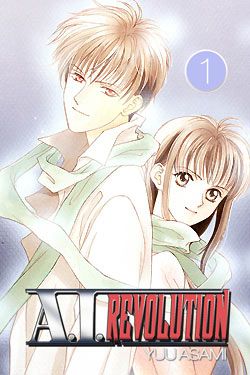A.I. Revolution is the story of a high school girl and her male robot companion. Unlike another series with a superficially similar premise, this one’s actually pretty good.
A.I. Revolution, Vol. 1
By Yuu Asami
Go! Comi , 216 pp.
Rating: Older Teen
Score: B
By the year 2020, the incorporation of helper robots as household aides has become a commonplace thing. Most of these still bear a machine-like appearance, however, so when Sui Makihara’s dad, head of a robot manufacturing company, creates an incredibly human-like model, it’s quite an achievement. He entrusts the raising of this robot to his daughter, who dubs the robot Vermillion and exposes him to various life experiences, like rescuing kittens and skiing. Though he seems content to be with Sui and make her cutesy bento lunches, Vermillion actually possesses some special skills, like the ability to interface with computers, which makes him the target of a scientist with dreams of ruling the world.
The five chapters included in the first volume are episodic, the events spanning a year of Vermillion and Sui’s time together. Some are more successful than others—the best is probably the chapter that introduces Kira, another human-like robot with a bodyguard specialty and eye-catching good looks, and the worst the story about the girl who hates robots because her father sacrificed his life to protect one—but overall they’re pretty enjoyable. They do get a little repetitive in one respect, though: in nearly every chapter, a building is in jeopardy of collapsing, providing ample opportunities for Vermillion to protect Sui from falling debris.
The story does have some problems. It’s got some internal inconsistencies—how could Kira have been built before Vermillion, as he claims, when the scientist responsible for his production is the same one who fled Sui’s dad’s company after he was caught trying to steal Vermillion?—and the characters are kind of bland, with the exception of Kira. Vermillion and Sui are pleasant, but that’s about it. Also, though they’re fond of talking about how important the other one is to them, they don’t really show it much.
Likewise, it’s got good points. One thing I thought was interesting is that the robots seem to have factual knowledge about things without understanding what they mean to humans. For example, Vermillion recognizes some tremors as heralding an earthquake but it doesn’t register with him that this qualifies as an emergency situation to humans. I also love the interaction between Vermillion and Kira and the conversations they have together, like this one:
Vermillion: Good morning, Kira. How’s your artificial skin feeling this morning?
Kira: Oh, it’s great. How about you? Any abnormalities with your integrated circuits?
Vermillion: They are doing fine. Thanks for asking.
Also, there is a Voltron joke.
The material in this volume was originally published in the early '90s, meaning the art looks a little dated to modern eyes. It’s not a hindrance to enjoying the story, but it does mean that one’s in for a lot of cinch-waisted jeans and other kooky fashion choices.
A.I. Revolution has a lot of potential. I confess a preference for a more serialized storyline, but perhaps it’ll go that route once it finishes introducing the world and its characters.
Volume one of A.I. Revolution is available now.


